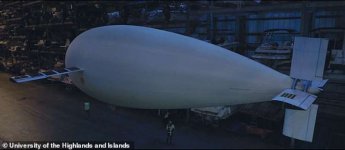- Reaction score
- 33
- Points
- 560
Not really an aircraft the way we usually think of it, but rather a hybrid of an airship and an airplane. It seems to work a bit like the Seaglider UUV by changing displacement. A silent, long endurance UAV would be an interesting addition to the ISTAR suite, and depending on how scalable it was it could fill a number of roles.
Plane that is lighter than air and can stay airborne indefinitely thanks to revolutionary helium technology
Plane that is lighter than air and can stay airborne indefinitely thanks to revolutionary helium technology
An innovative balloon-like aircraft capable of fast transitioning between two states -being lighter than air and heavier than air - has been flown for the first time.
It adopts a technique known as variable-buoyancy propulsion, commonly used in underwater vehicles.
The Phoenix, designed by academics in Scotland, is powered by the thrust created when such cycling happens at high speeds.
Its frequency allows the craft to glide through air like an aeroplane rather than move up and down like a balloon.
According to its creators, the engine-less craft can sustain forward motion for long periods and could be a cheaper alternative to satellites.
The Phoenix was tested over a distance of 394 feet (120 metres) in laps at an indoor storage facility in Portsmouth.
It is powered by technology known as variable-buoyancy propulsion that drives it forward like a plane.
When the aircraft is filled with helium gas, it's internal balloon-like structure becomes lighter than air and lifts upwards.
A separate bag inside the balloon is then used to draw in air from outside which is then compressed it to make the craft heavier and move downwards.
This fast and constant cycle between the two masses means the Phoenix can travel like an aeroplane, rather than move up and down.
The craft, also called an ultra-long endurance autonomous aircraft, measures 49ft (15m) long with a wingspan of 10.5 metres and weighs 19 stone (120kg).
Andrew Rae, Professor of Engineering at the University of the Highlands and Islands Perth College UHI Campus, led the design of the aeroplane said: 'The Phoenix is designed to repeatedly transition from being lighter than air to being heavier than air so thrust is generated to propel the craft forward.
'The Phoenix spends half its time as a heavier-than-air aeroplane, the other as a lighter-than-air balloon.
'The repeated transition between these states provides the sole source of propulsion.
'The vehicle's fuselage contains helium to allow it to ascend and also contains an air bag which inhales and compresses air to enable the craft to descend.
'This motion propels the aeroplane forwards and is assisted by the release of the compressed air through a rear vent.
'This system allows the Phoenix to be completely self-sufficient. The energy needed to power its pumps and valves is provided by a battery which is charged by lightweight flexible solar cells on its wings and tail.
Referring to the practical usage of the innovative aircraft, Professor Rae said: 'Vehicles based on this technology could be used as pseudo satellites and would provide a much cheaper option for telecommunication activities.
'Current equivalent aeroplanes are very complex and very expensive. By contrast, Phoenix is almost expendable and so provides a user with previously unavailable options.'
According to the research team, the test flight was the work of a three-year project studying how effective variable-buoyancy was at powering a large scale aircraft.
The team says it is now exploring collaborations with major manufacturers to take the technology to the next phase of development.
HOW DOES 'VARIABLE BUOYANCY PROPULSION' DRIVE THE PHOENIX?
The terms refers to the transition of an object between two states: being lighter than air (causing the object to lift) and being heavier than air (causing the object to fall).
The difference to a hot air balloon is that the transition is so fast that it creates thrust which allows the craft to travel like a plane, moving forward in a horizontal plane rather than up and down.
When the Phoenix is filled with helium gas, it becomes lighter than air and moves upwards.
A separate bag inside the balloon draws in air from outside and compresses it, making the Phoenix temporarily heavier than air and move downwards.
This cycling between the two happens so quickly that no up and down motion is observed; instead the craft is propelled forward and glides like a plane.
The technique known as variable-buoyancy propulsion is used for crafts underwater but this is the first time it has powered a large craft in air.


